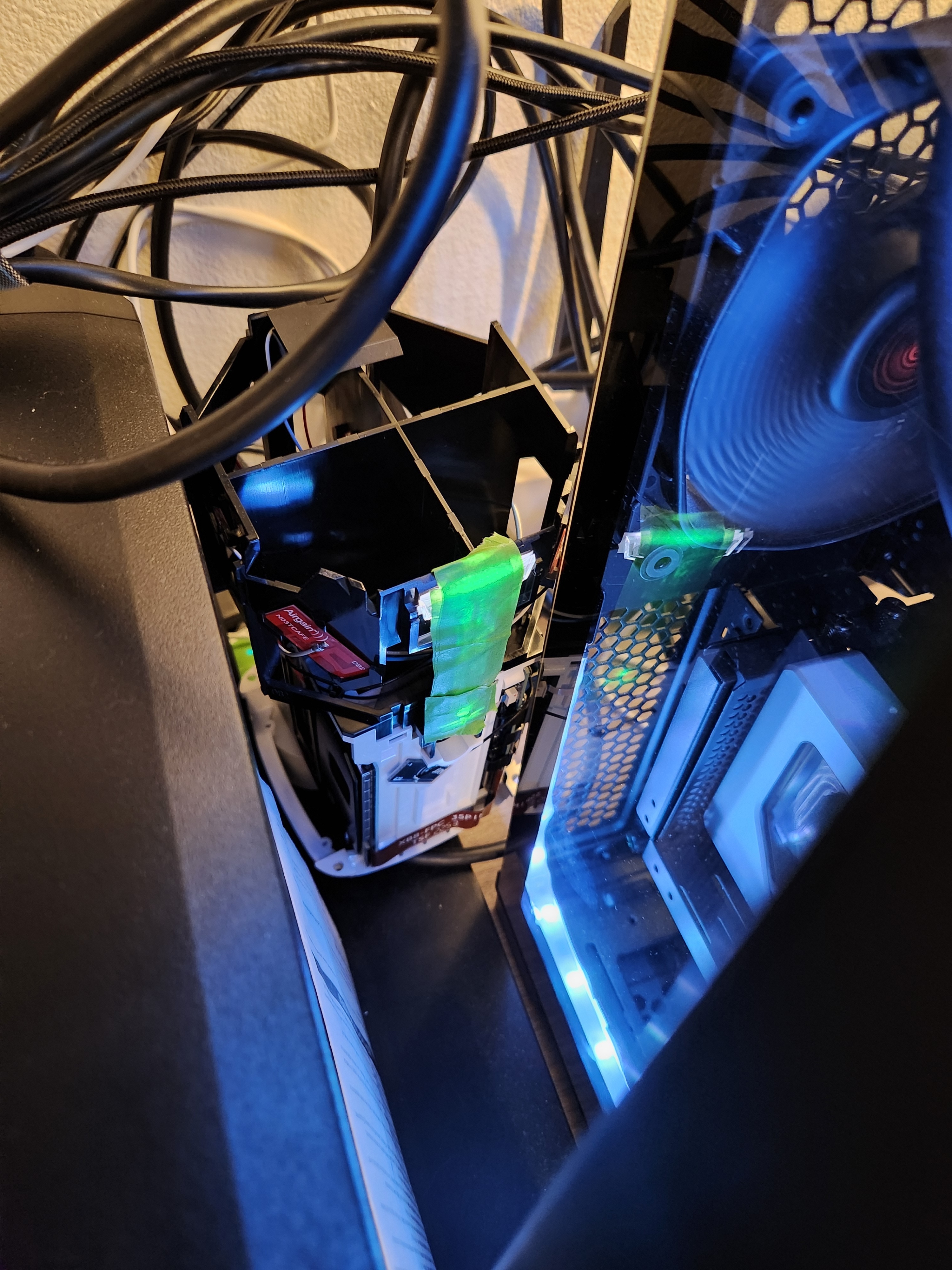So that’s the perfect excuse to buy a 3D printer right there! Go for it! :)
I envy you, some of us really have to search for such an excuse!
As if they don’t already have a borderline hobby 🤣
It was engineered for passive cooling, even if just barely. I don’t think you need something as elaborate as a case fan when the whole thing is perforated like that. A single USB fan blowing on the case from 6 inches away is sufficient to keep my formerly toasty modem barely warm to the touch.
They’re also engineered with the assumption that there is nothing within a 6 in radius and it is kept in a 70F room. Those are assumptions that often aren’t true and lead to them overheating all the dang time.
Do you need me to print you a solution?
Wait, really? Like 3d print something? I was actually toying with that idea but I haven’t dipped my toes into 3d printing yet and don’t have much time lately.
For sure! What part of the world are you in? I have that same unit, so maybe I could cobble something together, but I’m not having your same problem with it (yet?)…
Small adapter that clips into the premade holes and has screw attachments for the fan. Dont have the unit for design purposes but could print the part (mid europe)
I’m in Canada - I’d be more than happy to pay for shipping and supplies but if it’s too much work or ends up being too pricey then don’t worry about it. :)
No worries at all! Are you able to send detailed, clear pics of what you want and how it needs to fit? Feel free to DM me, I’m game to give this a try. (Also, PacNW)
Oh, and before I forget: are you able to remove the top of the unit to give small zip ties a try?
Hey! You have the same shitty AIO that Comcast sent me! It overheated and tries to melt itself down all the time. Luckily it gets so hot that the adhesive melted and the screws were easily visible. I just took the chassis off and it mostly doesn’t overheat anymore.

Crazy, the thing is basically hollow and was right next to the window and would still overheat. The bottom doesn’t allow for any air intake so it sufffocates. Also it’s 80% plastic because they couldn’t be assed to add aluminum heatsinks.
Oh my goodness, this is the first time I’ve seen the innards of that AIO (all in one?) on the internet. Thank you! Where were the screws located on it?
They are all on the bottom, the rubber feet/stripping on mine started coming off, found it by mistake. One has a sticker, but those don’t really hold up to void warranties anyways. Plus, I’m just gonna super glue the rubber feet back on after, hahah. I just tucked the screws and the chassis in the back of a closet for now. No tabs or anything to break when uninstalling it, either!
Edit: yeah, all in one! Mine is one of those modem / wifi combos. I set it to bridge mode so I could use my own router, and the thing still overheated even though it was just acting as a modem, smh. Annoying how bad it is. Luckily, shucking it will clear up 9/10 problems. Put some tape over the LED if you sleep in the same room as it, it’s very bright when exposed.
So I finally shucked mine and found a 40mm fan in the bottom that wasn’t running. In fact, I don’t think it ever has run since I never feel any air flow or hear anything. Did your XB8 have a fan?
Yeah, mine has one and it runs, but infrequently and at such a slow RPM it does very little. Shucking it was the only thing that seemed to help!
They should have gone with one of these thicker 30mm (thick) fans. They move a lot more air than even a standard PC fan, but do it quietly.
https://www.phanteks.com/PH-F120T30.html
Though one has to wonder why it needs cooling at all. I’ve never had an actively cooled network device before, and most of my equipment hasn’t even gotten more than marginally warm due to excellent venting.
Oh yeah that would be a great alternative! It’s funny, I’ve been wondering the same. It’s in bridge mode, has a MASSIVE heatsink and a fan but is still super hot. Does modems really get that hot? I’d be curious to inspect what kind of traffic is coming out of the modem because my pihole isn’t catching anything from my router-onwards.
Not sure! Does seem…oddly inefficient, though.
In the Netherlands, the ability to swap in your own modem is safeguarded by law. I have luckily not had to deal with this.
That said, would look to see if you can remove the whole top, seems to me it would be clipped in. Then place a matching size fan, or just undersized and 3D print a rim.
I usually do a very not ISP sanctioned modem swap/delete.
Depending on the type of modem, you may be able to simply replace it with something else and the ISP may not have any way to really differentiate between the modems.
Is this for cable, DSL, or fiber?
A model number can really clarify a lot.
Whoaaa that could be great. Wouldn’t do anything if your isp already had you being cgnat though right?
depends on what you mean by “do anything”. I’ve managed to shed several ms of latency by doing a modem delete.
My two favorite stories of this were for the local DSL/fiber provider here in Canada, Bell. They use vDSL2, and GPON/XGS-PON respectively. In the former case, I set up a node at my house, which was a Cisco ISR router, with a vDSL2 EHWIC card installed; after some work, I managed to get the unit dialing into the internet via PPPoE, and I managed to drop about 5-10ms of latency simply by removing the ISP provided garbage. It was also clean… a single phone cable plugged directly into the router, and out the other side was a switch, which provided all the network connections I required… my setup was a tiny bit more complicated than I’m explaining, but the other details don’t really matter (long story short, I was operating on a Bell line through a wholesale client (third party ISP using Bell’s “last mile”), and they provided me with a /29 subnet for internet routing - the Cisco handled the WAN to WAN communication, and on my /29, I had a few devices including my primary firewall, which was between me and the internet, that then broke out onto a switch for everything to connect to… a bit more than the average joe can handle, but I work in networking). The other story is about their GPON; I managed to figure out that their GPON interface is almost entirely unprotected, and worked with a G-010S-A (a fairly common design from Nokia, but has variants from other major vendors that are largely the same), so by buying or otherwise obtaining one, and programming it very specifically, you can actually plug the SFP GPON module directly into a router, and with some clever configuring, get your PPPoE to work across it without too much trouble. There’s plenty of info about it online if you want to see more.
The only sad story I have about this is that Bell started to release a new modem that has a built in fiber module (no longer using the G-010S-A), which is compatible with both the GPON and XGS-PON systems; I have yet to find an XGS-PON version of the G-010S-A that I can use for the purpose. A friend of mine, whom I did a modem delete for with the G-010S-A, was in an area that was originally served by GPON, so the solution worked. After some time though, Bell implemented XGS-PON in his area, and actually removed compatibility for the GPON, so the solution stopped working. Until I find an XGS-PON equivalent to the G-010S-A, I’m at an impasse. In the interim, my friend has put his modem back in-line, and IIRC put it into bridged mode, which is second best to a modem delete.
I’m a network technician/engineer as my dayjob, so working with this stuff is entirely in my wheel house, I can usually give useful advice for anyone wanting to walk in my shoes to delete their modem, and make it simple enough that it doesn’t require my level of skill to maintain (like in the case of my friend), and advice/strategies about how to handle the ISP.
CG-NAT is entirely in the ISP hands, I cannot touch their fancy CG-NAT engine or route around it. My best advice for anyone facing down CG-NAT, is to use IPv6, if your ISP supports it. Simply put, the best argument I’ve seen for IPv6 adoption is CG-NAT. NAT itself was bad enough, but CG-NAT is a whole new level of evil; it breaks so many things. IPv6 takes you back to the old days of globally routable addresses, end-to-end, completely eliminating the need for any kind of NAT. A large portion of the internet uses/supports IPv6 already, pretty much all the major data carriers support it and actively use it for their own gear (people like google, facebook, apple, microsoft, cloudflare, etc). IPv6 shouldn’t be feared, as an end user, the whole thing is going to behave exactly as you expect it to. The trick is: getting it up and working on your LAN, once you can work that out, you’re laughing.
Wow this comment rules. The ISPs in Mexico are very locked down, just to make money. A fixed ip costs $25 per month for example. Do you need them to assign a fixed ipv6 address?
If you require v6 to be static, the ipv6 equivalent to a static IP is a static /64 subnet, aka, an entire LAN. Since it’s globally routable, it needs to be issued by an RIR, the same way an IPv4 address would be.
So yes, they would issue it.
If they don’t have facilities for ipv6, there are options, such as getting an ipv6 over IPv4 tunnel going with someone like he.net. such tunnels add complexity and more work to the set up and rely on you having a very flexible router, but can be a good alternative.
Ah yeah, these guys are really strict about shit, there’s literally only one provider that lets residential customers use a fixed ip. the rest require a corporate account. I don’t think they’re gonna even know what ipv6 is lol
They’re all seemingly very strict about using their gear. They all are, they always are. They’re lying when they say that things aren’t compatible or something.
The biggest lie is that you can’t. You can, and most of the time, unless it’s creating a problem, they couldn’t give a shit less if their equipment is working correctly; as long as you pay your bill, and don’t complain, they don’t give a shit. They have your money, whether things work correctly isn’t their primary concern.
Likely won’t change CG-NAT config, the new modem would still have to get its IP address from the attached ISP
Can you elaborate? My ISP forces me to use their modem.
In the US at least, I haven’t heard of a provider not allowing you to bring your own hardware. For example, on Comcast, you can bring your own DOCSIS 3.1 modem that isn’t as full of software and doesn’t allow neighbors to use an Xfinity public network. Comcast even has a page for compatible devices. Save on stupid rental fees.
That’s true for cable, but I haven’t found it to be possible with fiber.
I’m in Europe and I once asked the support and they said I cannot connect without at least using their router as a modem (in bridge mode).
So I could use my own router for my home network but would have to connect it to their provided one.
I was curious if there was some hack to make it work without their shitty provided one.
It’s very situationally dependent. In many cases though, the only thing restricting you is the ISP not giving you the information to do it yourself, and sometimes, just sometimes, some kind of code or MAC address that limits what devices can operate on their network; though that’s usually set up for billing.
If you use any kind of PPPoE, the MAC address problem usually isn’t a thing; this is normally DSL/Fiber… not all fiber, just some. PPPoE needs authentication which usually means username and password login to do AAA for the client, because of this, there’s little to no security on the last mile. All these technologies are based on standards. Fiber is usually GPON, DSL has several standards, but modern DSL is usually vDSL or vDSL2, or some variant thereof, and Cable is generally DOCSIS 3 or 3.1. There are exceptions, but they’re not common.
The key is to find which specific technology the ISP is using, and find alternatives. In the case of DSL, it’s generally finding a DSL modem that uses the same profiles and annex as the provided modem; beyond that, plug it in and authenticate with PPPoE. Many PPPoE type providers use a circuit number and/or VLAN, so that generally needs to be set along-side the PPPoE credentials.
For DOCSIS, it’s a bit sticky, since I know of many cable providers who authenticate endpoints based on the MAC address of the modem; in which case, you not only need to find a modem that can support the protocols in use, and the channel widths (eg. DOCSIS 3.1 16x8), but also one that you can modify the ISP-facing MAC address on the DOCSIS interface to match the one they gave you.
For Fiber, things can be sticky, but often aren’t. The ISP can, but often doesn’t filter on all of the following: MAC, SN, SLID. All of these values are sent to the OLT (ISP side of the fiber), and it could fail on any one of them. For me, I’ve had success with the G-010S-A SFP module, and if you look around the internet, you can find a git repo that actually has all the commands to modify any/all of these values to match them to whatever the ISP provided to you. The most difficult is getting the SLID, since it’s not published on the outside of the modem. I managed to get my local GPON’s SLID from a G-010S-A module that I hijacked from a working modem; in that case it was a string of all zeros.
The information is out there if you look hard enough, and with a little bit of cleverness and ingenuity, you can usually find anything that’s missing.
I work in Networking (aka network engineering, aka a bunch of other titles), so this all comes very naturally to me; to give you some examples, one DSL modem delete I did for myself was to pick up an EHWIC-VA-DSL-M for a Cisco ISR router, after some configuration magic, which I won’t get into here, I was able to get it to connect to my ISPs DSL line, after a bit more configuration magic, the Cisco was handling all of the traffic from my network to the DSL. It was a very clean setup, only requiring a single phone line from the wall plugged into a module on the router, then on the other side of it (over ethernet) was my network. That’s a fairly advanced one, but I’m pretty proud of it. Another case was a friend on the same last-mile provider in my country, on a fiber line, where I removed the garbage modem they gave him and replaced it with a G-010S-A GPON to SFP module, and plugged that more or less directly into the router he owned. In each case, I shaved off a few ms of latency, and bandwidth was largely unaffected. It makes the internet run just that much faster than before, and puts the control in your hands.
Needless to say, the ISPs don’t want you doing this, and they don’t approve, but in general, you can do so without their involvement and for the most part, they are entirely unaware that it’s happened.
Let me know what situation you’re in and we can probably devise a solution to the garbage ISP modem issue. Frankly, the fiber modem delete is my favorite.
Dare I ask what happens if the gateway doesn’t have this auxiliary cooling? Does it drop packets? Something worse?
Gets really hot and speeds/stability decrease.
World devastation
To protect the world from devastation
To unite all peoples within our nation
It likes to drop me from the middle of games when my same unit overheats :)
Fuck Comcast and fuck the “Made with ❤️ in Philadelphia” team that designed this complete POS. It has a built in cooling fan (lmao) and still overheats! It’s a mostly empty modem that is almost the size of a shoebox, lol. It gets so hot that the adhesive on the bottom starts coming off.
How about setting it on top of a laptop cooling pad?
Fritz Box ftw
without damaging
Means not to open the closure?
I’m not seeing any exposed screws. I could try a plastic spudger but would like to avoid it. Even trying to open my ASUS router was a PITA as it was designed not to be opened.
Ok yes then its probably better to keep it that way.
3D printer. Get one, find someone with one, library, etc.
I own so my ntd is running a 120mm fan in a custom secured chassis
Can you get zip-ties in those holes?
I may be able to get the smallest available zip ties in there. Maybe it’s possible to bend a wire and hook it through one hole and up another.
The plastic and wire twist ties that come on cables would work too.
Ah, good idea.
Bend the end of a zip tie into a U shape roughly the size of hole spacing and try feed it in one hole and out another.
Do you have the option to bring your own equipment?
This is definitely the better solution if your ISP supports it. ISP provider gateways are always garbage the auxiliary cooling may help but it will always have issues
Internet Service Provider Provider
(i cant help myself)
To be fair depending on who we are talking about it’s not inaccurate a lot of providers are just reselling someone else’s service
I can’t disagree with that.
Unfortunately my ISP doesn’t let me. I’ve had luck in the past improving stability with fixing the terrible thermals but this time around I’m trying to make a cleaner solution. Though I’d love to just run my own modem ideally.
I wish!! Nearly no ISPs in my country allow you to bring your own modem, so I have this bridged to my own router/access point. And yet it still gets very hot to the touch which certainly throttles the CPU.
What is the make and model of the thing your stuck with?
That’s weird that in bridge it gets that hot. Certainly not what is expect.
It’s a technicolor something.
It’s Comcast’s standard gateway now too
It’s an XB8 which I’ve heard mixed reviews on. Haven’t found any teardowns online so far though.
So, did some reading as I’m not familiar with what you have. You’re supposed to be an internal fan… Guessing the one in yours is possibly broke.
Since it’s the ISPs device, you could call and say you hear a loud annoying grinding sound like a fan dying (Even though it’s probably already dead) and that you want to replacement unit. And then while you have him on the phone double check their current policy on bringing your own modem and ask for a manager to double check for you ‘as you don’t want this issue to keep happening’
Something like Sugru might work. It has a strong bond but can easy be peeled or sliced off later. Any lingering residue can be cleaned off fairly easily.
deleted by creator






